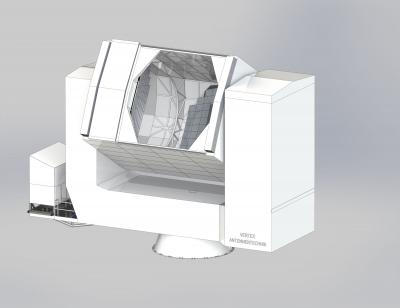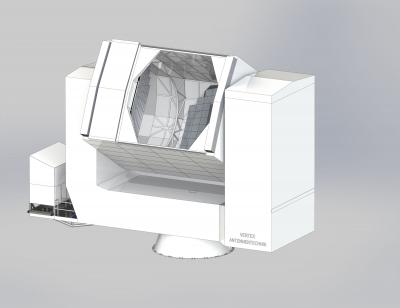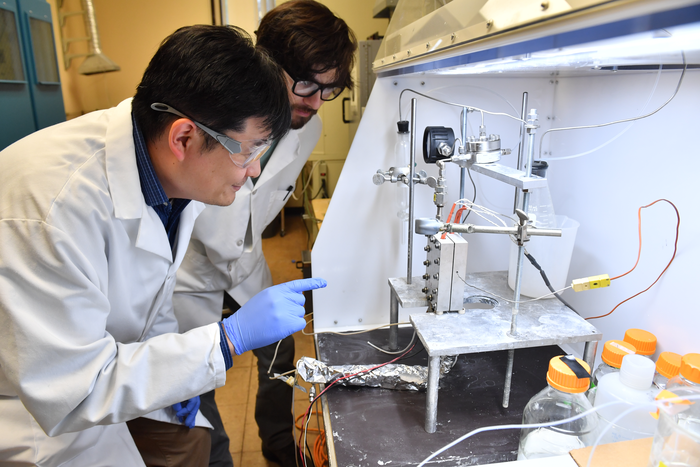
Credit: Vertex Antennentechnik GmbH, Germany
ITHACA, N.Y. – A unique and powerful telescope capable of mapping the sky at submillimeter and millimeter wavelengths is headed to South America. With a slated completion date of 2021, the 6-meter aperture telescope, Cerro Chajnantor Atacama Telescope-prime (CCAT-p), will be located near the summit of Cerro Chajnantor in the Atacama Desert in Chile. It will give unprecedented insights into how stars and galaxies form, what lit up "cosmic dawn" – the time a few hundred million years after the Big Bang when the first stars were born – and the formation and dark-energy-driven expansion of the universe.
A consortium of U.S., German and Canadian academic institutions, led by Cornell University, are overseeing the project. The telescope's novel optical design, high-precision mirrors and high-altitude location (over 18,000 feet) will establish the CCAT-p telescope as a premiere facility for astrophysics and cosmology research.
"The CCAT partnership has now spent more than a decade exploring the possibility – and challenges – of building a state-of-the-art telescope at this amazing site. During that time, technology and submillimeter science have advanced at a very rapid pace, and we are now ready to move forward to build a truly exciting telescope," said project director Martha Haynes, Cornell's Goldwin Smith Professor of Astronomy.
The siting of the telescope at such a high elevation, in such a dry place, will prevent water molecules in the Earth's atmosphere from impeding the detection of submillimeter radiation, allowing routine observations at these wavelengths. The location and design will also allow observations of about 80 percent of the sky through all seasons.
The telescope will open the highest frequency radio windows accessible from the ground to study, among other things, the detailed physics of star formation in the Milky Way and the local universe.
Its highly efficient mapping capability positions the CCAT-p telescope as a platform for next-generation cosmic microwave background (CMB) experiments. "There has been a lot of excitement in the CMB community about CCAT-prime," said Michael Niemack, Cornell assistant professor of physics, who designed the telescope optics.
"The location appears to be the best-known site on Earth for millimeter and submillimeter wavelengths, and with CCAT-prime we will be able to map the CMB roughly 10 times faster than current telescopes."
The innovative telescope design can dramatically improve measurements of polarized signals that may contain "fingerprints" from the time of inflation, a trillionth of a trillionth of a trillionth of a second after the Big Bang. With CCAT-p, scientists will be able to make direct measurements of galaxy cluster motions under the influence of dark matter and dark energy; study how galaxies and galaxy clusters first evolved; and study the properties of neutrinos, some of the lightest known fundamental particles.
"It is exciting to see this important project become a reality," said Cornell Provost Michael Kotlikoff. "Our faculty have long championed the scientific significance of CCAT, and it continues Cornell's strong legacy of leadership in the field of astronomy."
CCAT-p is being constructed by Vertex Antennentechnik GmbH of Duisburg, Germany. The CCAT corporation is a partnership of Cornell, the German Universities of Cologne and Bonn, and Canadian Atacama Telescope Consortium (CATC), a consortium of Canadian academic institutions. Faculty and staff at several other institutes in the U.S., Canada, Chile and Germany are also involved in science planning and instrumentation development.
Jürgen Stutzki of the University of Cologne noted: "The innovative design of the telescope, enabled by the high-tech capabilities of the German company building the telescope and its location at an extreme altitude, enables breathtaking new science blocked at lower altitudes. CCAT-prime will also be an essential platform to deploy new quantum detectors at the cutting edge of physics developed at Cologne, which enable ultra-sensitive observations."
As the founding project director, Riccardo Giovanelli, Cornell professor emeritus of astronomy, noted, the success of the project, and Cornell's leadership, is largely the result of financial support from alum Fred Young. "The project wouldn't be going forward without Fred's vision and intellectual passion," said Giovanelli. In addition to the $5 million Young has contributed toward the development of the CCAT concept, he has committed an additional $7.5 million to CCAT-p.
###
Media Contact
Daryl Lovell
[email protected]
607-592-3925
@cornell
http://pressoffice.cornell.edu
############
Story Source: Materials provided by Scienmag






